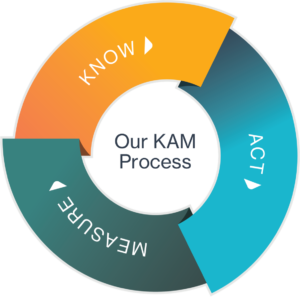How to Build a Kick-Ass Account Plan
in Customer Engagement /Customers have never been harder to engage or easier to lose. The data on this show that only 29% of B2B customers are engaged, 69% are ready to take their business elsewhere, and 47% believe their vendor delivers on its promises. The good news is that your customers want you to understand them and build a relationship with you. Building a kick-ass account plan is an effective way to overcome these challenges and give your customers what they really want. Doing so gets you to the level of being a trusted advisor or a strategic partner to your customers while increasing your revenue and retention results.
Ingredients of an account plan
So, let’s go through the process. There are four elements of a kick-ass account plan. You’ve got to:
- Follow a structured process.
- Make sure you include all the right components in your process.
- Bring it to life with regular account reviews. They need to be living, breathing part of how you interact with your customers and with your team.
- Validate your account plans with your customers. Don’t just create them for yourself. Really take that extra step. Go to your clients and work with them. Make sure that you’ve got the accurate representation and that your plan is built based on their needs and their goals.
Now let’s take a closer look at these elements.
The process
We have developed a process called Our KAM Process™. KAM stands for Know, Act, Measure. Our KAM Process is portrayed as a wheel because it is a repeating process.

Know
You constantly want to be asking yourself questions relating to how well you know your customers, how to go deeper with them, what data or information you have about them, what your strategy is, and which are the critical relationships. That’s the type of information in the knowledge piece of your customer.
Act
Then, based on that information, what are you acting on? How do you make sure you’re moving from knowledge into action and doing things to help improve the customer’s situation to get them closer to success? That’s what Act is all about—how you ensure your daily/weekly activities are aligned with what the customer considers most important.
Measure
Measure is about tracking how well you’re doing in relation to each client. Determining how well you understand the value the customer cares about, whether you’re hitting milestones or goals, and communicating those achievements with the customer.
Our Know, Act, Measure Process is a cycle that constantly repeats. It’s a great framework for you and your teams, because it’s easy to understand and is a powerful account planning approach. If you do Our KAM Process properly, you’ll have better alignment with your customers, more accountability back and forth, more clarity on who’s doing what, better revenue growth, and a guide for your work. Plus, your customers are going to benefit by having a better experience.
The five components of an Account Plan
No matter where you store your account plans, there are certain critical elements you need to include in them.
- The customer details such as who the client is, what they have bought from you, what you know about them, and what the relationship looks like. This basic information can be used to determine where each customer ranks in terms of things like revenue, profit, and potential.
- An org chart is about critical relationships and understanding the key contacts you have within the organization. It’s not a complete list of hundreds of contacts within an account. That may be useful to Marketing, but it isn’t useful for an Account Manager, especially a Strategic Account Manager who needs to build strong personal relationships with specific people. So, focus on the top 5-10 critical relationships and map them out on an org chart. Then understand who likes you, who doesn’t, and what their key goals and initiatives are.
- A SWOT analysis is an opportunity to objectively and thoughtfully look at the customer and their environment. This analysis involves strengths, weaknesses, opportunities, and threats. The first two, strengths and weaknesses, are about you and your company in relation to the customer. Here’s where you need to evaluate what the customer likes about what you’re doing, what successes you’ve had with them, where you’ve had issues, and any risks or weaknesses you need to mitigate. Opportunities and threats are about the customer within their environment. It’s where you look at what’s happening in their industry, in the macro economic environment, and the regulatory environment as well as other things happening in the customer’s own world. Then evaluate how they might impact your customer. The SWOT helps you understand what you know about the customer and what they think about your company while identifying blind spots and questions you still have relating to the customer.
- Voice of Customer (VOC) is a conversation. It isn’t an NPS or customer satisfaction survey. It’s where you speak with some of the most impactful senior people at your customer site. You ask for 20 minutes of their time to talk about what’s going on for them. When you meet with them you should ask open-ended, future-focused, and strategic questions. And these questions all need to link back to the customer. This is your chance to understand where you stand with this client, what’s working, what’s not working, and how you can be a better partner to them. The VOC is a way to build support with executive contacts within your customer accounts.
- An Action Plan takes all the knowledge you have about your customer from gathering customer details, putting together their org chart, conducting a SWOT, and completing VOC interviews. At this point you know your customer’s goals, understand what would make them stay with you, what they value, and how they will measure success. Now it’s time to determine which goals are in your wheelhouse and how you can help your customers reach them. You are now ready to prepare specific plans consisting of objectives, actions, and smaller tasks to be completed daily, weekly, and monthly to consistently work toward achieving those customer goals.
Once your action plan is ready, you need to communicate it to everyone in your company who’s involved and make sure they’re all on the same page. Then, remember to refer to this plan and routinely adjust it to stay aligned with the customer’s goals.
Bring Your Account Plans to Life
You don’t want to create plans for yourself and simply store them in a desk drawer or on your computer desktop. You need to evangelize them within your organization as a champion for your customers. The most effective way to do this is by having a regular account review meeting– a regularly scheduled meeting, typically on a monthly basis. Account reviews are meant to be conversations with your whole team, including individuals like the salesperson, customer success, service, professional services, and marketing. This is where you talk about the client using the Know, Act, Measure process to guide the conversation. It’s a chance to ask questions and collaborate as a team. Plus, it ensures all team members are up to date and aware of any changes.
Validate Your Account Plans
Once you’ve built your plans, it’s time to share them with your customer. Many key account managers don’t want to share this with their clients, but it’s important to do so. If you’ve built a great account plan, it shows how well you know your customer and how well aligned you are with what they consider to be success. This makes you look smart and valuable when you show up and share what you know. You can review all the components of your account plan for them including the org chart, goals, and VOC interviews. Then, ask them if it looks right and what they think of it. Discuss the details and ask any questions where there are gaps in the information you have. This shows your client how prepared, thoughtful, and objective you are about the relationship. And they will view you more strategically and as a trusted advisor. The result will be a deeper relationship with your client and overall positive results in the long run.
Conclusion
So those are the four components of the kick-ass account plan. Follow Our KAM Process. Include the key components in your process. Bring your plan to life with routine account reviews. And validate your account plan with your client. Doing so will increase your revenue and retention rates.
Need help getting started with this process? Check out our account management training videos and download our account planning template from the course. We will guide you through building your own kick-ass account plan step-by-step.







